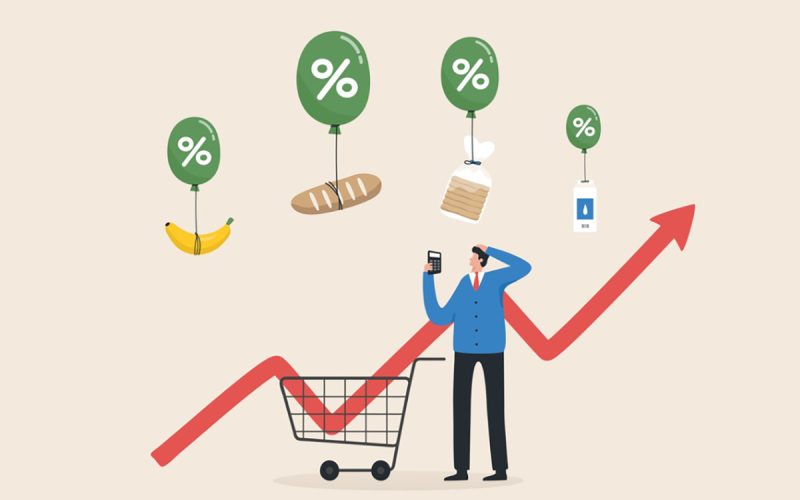Household Savings Erosion

High inflation reduces purchasing power, eroding household savings. As inflation rates climb in 2024, the value of money diminishes, meaning that the same amount of money buys fewer goods and services than before. This reduction in purchasing power directly affects household savings, as the real value of saved money decreases, eroding the financial security families have worked hard to build. Households find themselves spending more to maintain their standard of living, leaving less room for savings. Inflation-driven price increases outpace household income growth. While wages may rise, they often do not keep pace with the rapid increase in prices of essential goods and services. This disparity means that even as incomes grow, they lag behind the cost of living, further straining household budgets and making it increasingly difficult to save for the future.
Real Estate Market Fluctuations
High inflation’s role in 2024 real estate price volatility is significant. As inflation rises, the cost of building materials and labor also increases, driving up the overall cost of real estate development. This leads to higher property prices, making it harder for potential buyers to afford homes. Additionally, inflation can create uncertainty in the market, causing fluctuations in property values as investors and buyers react to changing economic conditions. Impact of high inflation on mortgage rates and affordability is profound. Central banks may raise interest rates to combat inflation, which in turn increases mortgage rates. Higher mortgage rates make borrowing more expensive, reducing affordability for homebuyers and potentially slowing down the real estate market. This can lead to a decrease in home sales and a potential cooling of the housing market, affecting both buyers and sellers.
Investment Strategy Shifts
Adapting portfolios to counter high inflation in 2024 becomes a necessity for investors. Traditional investment strategies may not suffice in an inflationary environment, prompting investors to seek assets that can provide better returns or preserve value. This might include investing in commodities, real estate, or inflation-protected securities. Diversifying assets to mitigate high inflation risks is another crucial strategy. By spreading investments across various asset classes, investors can reduce the impact of inflation on their portfolios. This diversification helps in balancing the risks and returns, ensuring that not all investments are adversely affected by rising inflation.
Social Inequality Widening
High inflation exacerbates wealth disparity among social classes. As the cost of living increases, those with higher incomes and more substantial savings can better absorb the impact, while lower-income households struggle to keep up. This widening gap between the wealthy and the poor leads to increased social inequality. High inflation disproportionately affects low-income households’ purchasing power. These households spend a larger portion of their income on essential goods and services, which are often the most affected by inflation. As prices rise, their already limited budgets are stretched even thinner, making it harder to afford basic necessities and exacerbating financial hardship.
Currency Value Volatility

High inflation exacerbates currency value volatility in 2024. Inflation erodes the purchasing power of a currency, leading to fluctuations in its value relative to other currencies. This volatility can create uncertainty in international trade and investment, as businesses and investors struggle to predict future exchange rates. Inflationary pressures increase unpredictability in currency exchange rates, making it more challenging for companies to plan and budget for international transactions. This unpredictability can lead to increased costs and risks for businesses operating in global markets, potentially impacting their profitability and competitiveness.
Supply Chain Disruptions
High inflation exacerbates supply chain disruptions in 2024. Rising costs of raw materials, transportation, and labor due to inflation can lead to delays and inefficiencies in the supply chain. Businesses may struggle to manage these increased costs, leading to disruptions in the production and delivery of goods. 2024’s high inflation leads to increased supply chain costs, further straining businesses’ operations. Companies may be forced to pass these costs onto consumers, resulting in higher prices for goods and services. This can create a vicious cycle of rising costs and prices, further fueling inflationary pressures.
Consumer Confidence Decline
High inflation erodes purchasing power, reducing consumer confidence. As consumers see their money buy less, their confidence in the economy can wane. This erosion of purchasing power makes people more cautious about spending, leading to a decline in overall consumer confidence. High inflation leads to uncertainty, impacting consumer spending habits. Uncertainty about future prices and economic stability can cause consumers to delay or reduce their spending, affecting businesses that rely on consumer demand. This reduction in spending can slow economic growth and create a challenging environment for businesses.
Sectoral Performance Variations
High inflation impacts consumer goods sector profitability in 2024. Rising costs of raw materials and production can squeeze profit margins for companies in the consumer goods sector. These companies may struggle to pass on the increased costs to consumers without losing market share, leading to reduced profitability. High inflation leads to increased costs in the manufacturing sector. Manufacturers face higher costs for materials, labor, and energy, which can impact their bottom line. These increased costs can lead to higher prices for finished goods, affecting demand and potentially reducing sales. The manufacturing sector must navigate these challenges to maintain profitability and competitiveness in an inflationary environment.










